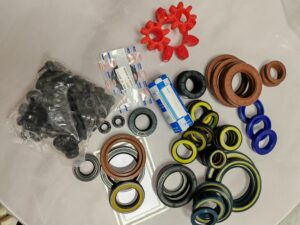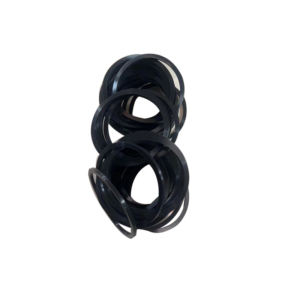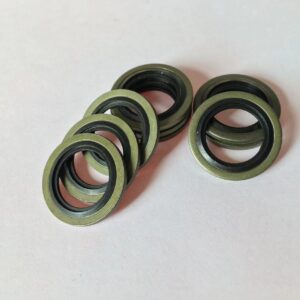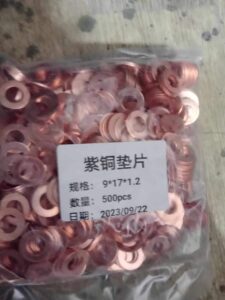Table of Contents
ToggleWhat is the difference between oil seal and gasket?
In mechanical sealing systems, both oil seals and gaskets play crucial roles in preventing leaks and ensuring the proper functioning of machines. However, despite their similar function, they have distinct designs, applications, and characteristics. Understanding the difference between oil seals and gaskets is essential for selecting the right sealing solution for specific mechanical systems.
1. Definition and Basic Concepts
Oil Seal:
An oil seal, also known as a shaft seal, is a mechanical component designed to prevent the leakage of lubricants and exclude contaminants in rotary applications. It is usually mounted around a rotating shaft, sealing the interface between the shaft and the housing to prevent oil, grease, or other lubricants from leaking out while keeping dirt, water, and other contaminants from entering the machinery.



Gasket:
A gasket, on the other hand, is a static sealing component used to seal two flat, stationary surfaces. It is typically used in applications where two rigid parts are bolted or screwed together, such as flanges or engine components, to prevent leaks of fluids or gases. Gaskets are not designed to handle movement, as oil seals are, but instead provide a seal when compressed between two surfaces.
2. Working Environment
Oil Seal:
Oil seals are designed for dynamic environments, meaning they are used in applications where parts are in motion. For instance, they are widely used around rotating shafts or in applications where a part exhibits reciprocating motion. They are designed to withstand movement, pressure, and often high temperatures and harsh chemicals.
Gasket:
Gaskets are used in static environments where there is no relative motion between the parts being sealed. Gaskets are employed between two stationary surfaces to prevent leaks, primarily in environments where pressure is relatively low to moderate. Common uses include sealing pipe joints, flanges, and engine components.

3. Design and Structure
Oil Seal:
An oil seal typically consists of three primary components:
- Sealing Lip: This component contacts the shaft to form a dynamic seal. It prevents oil leakage and stops contaminants from entering the machine.
- Outer Case: This part holds the seal and fits into the housing of the machine.
- Spring: A garter spring often surrounds the sealing lip to apply pressure, maintaining contact between the lip and the shaft, ensuring that the seal remains intact during operation.
Gasket:
Gaskets generally have a simpler design. They are usually flat and are made from a range of materials, including rubber, cork, or metal. The gasket is placed between two surfaces and compressed, creating a seal that prevents leakage. Gaskets do not have a dynamic component like oil seals, as they are used for stationary applications.
4. Types of Oil Seals
Oil seals come in various types to cater to different applications and requirements:
- Single Lip Oil Seal: Consists of one sealing lip and is ideal for low-pressure applications.
- Double Lip Oil Seal: Features two sealing lips, offering extra protection against contaminants and ensuring a better sealing function, especially in harsh environments.
- High-Pressure Oil Seal: Designed for high-pressure applications, often used in hydraulic systems.
- Low-Speed Oil Seal: Specifically designed for applications where the rotating speed is low.
- High-Speed Oil Seal: Used in applications involving high rotational speeds and designed to accommodate the increased friction and heat.
5. Types of Gaskets
Gaskets also come in various forms, each suited for different sealing needs:
- Flat Gaskets: Commonly used to seal two flat surfaces, they can be made from materials like rubber, fiber, or metal.
- Ring Gaskets: These are used in flanged connections and provide a sealed ring between the flanges to prevent fluid leakage.
- Spiral Wound Gaskets: These are made by winding a metal strip around a rubber core and are often used in high-temperature and high-pressure environments.
- Cork Gaskets: Used primarily in automotive and machinery applications, cork gaskets are flexible and compressible.
6. Materials of Oil Seals
The materials used for oil seals depend on the specific application requirements:
- Nitrile Rubber (NBR): Known for its excellent oil resistance, it is one of the most commonly used materials in oil seals. It is suitable for general applications but has limited high-temperature resistance.
- Fluorocarbon Rubber (FKM): This material offers superior resistance to high temperatures and aggressive chemicals, making it ideal for harsh industrial environments.
- Silicone Rubber (VMQ): Known for its high-temperature resistance, silicone is often used in automotive and other high-heat applications.
- Polyurethane (PU): Used for high-pressure and high-wear applications, polyurethane oil seals are extremely durable and resistant to abrasion.
7. Materials of Gaskets
Gaskets are made from various materials depending on the sealing requirements:
- Rubber: Provides excellent flexibility and is used for low- to medium-pressure environments. Common types include Nitrile, EPDM, and Viton.
- Metal: Often used for high-temperature and high-pressure applications, metal gaskets provide strength and durability. These gaskets may be solid or contain a metal core for added support.
- Cork: Used in automotive and machinery applications, cork is compressible and works well in sealing low- to moderate-pressure applications.
- Graphite: Often used for high-temperature and chemical-resistant applications, graphite gaskets provide excellent performance in severe environments.
8. Market Applications of Oil Seals
Oil seals are crucial in a wide variety of industries:
- Automotive Industry: Oil seals are used extensively in engines, gearboxes, and steering systems to prevent oil leaks and protect internal components.
- Hydraulic Systems: In hydraulic pumps and cylinders, oil seals help retain fluid and prevent contamination, ensuring efficient operation.
- Manufacturing and Industrial Equipment: Oil seals are used in machines that involve rotating parts or fluid systems, such as pumps, compressors, and motors.
9. Market Applications of Gaskets
Gaskets are used in diverse applications as well:
- Automotive: Gaskets are used in engines, exhaust systems, and HVAC systems to prevent leakage of fluids and gases.
- Piping and Plumbing: In plumbing and pipe installations, gaskets prevent leaks at joints and connections.
- HVAC Systems: Gaskets are used to create seals in air conditioning systems, ensuring that there are no leaks in the pressurized systems.
Conclusion
In summary, while both oil seals and gaskets perform sealing functions, they are distinct in terms of their design, application, and the type of sealing environment. Oil seals are used in dynamic environments where rotating or reciprocating motion occurs, while gaskets are used for static sealing between two stationary surfaces. The choice between an oil seal and a gasket depends on factors such as motion, pressure, temperature, and the type of fluid involved in the application. Understanding these differences ensures the appropriate selection of sealing solutions, improving the performance and longevity of the machinery.



Leave A Comment